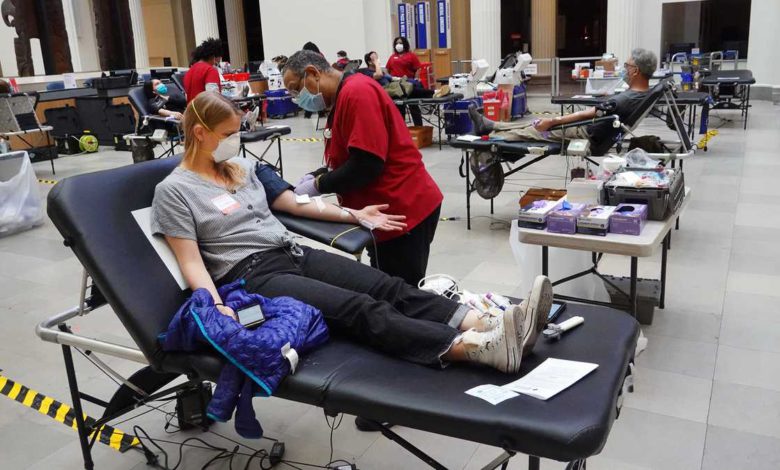

If you've ever considered donating blood, now is the time to take action.Blood donations are absolutely critical right now as the United States faces the worst blood shortage in over a decade, according to the American Red Cross website.Know your blood type? Type O-positive, Type O-negative and platelets are in the most need right now, the organization said.The Red Cross, which supplies 40% of the country's blood supply, has seen a 10% decrease in donations since March 2020.Blood donations are needed for all types of patients such as trauma victims and cancer patients, according to Jessica Merrill, director of biomedical communications for the American Red Cross."I know of a teenage cancer patient in New York who recently had to go without a scheduled transfusion due to the lack of available blood," Merrill said. "Imagine how hard it is for a parent to take their sick child home without the treatment they need to feel better."Many factors are causing the shortage, including canceled blood drives due to illness and staffing limitations, and an active flu season. Weather-related closures have also prevented some blood drives from taking place.A surge in COVID-19 cases could have also contributed to the ongoing shortage, according to the Red Cross.Additionally, there has been a 62% drop in college and high school blood drives during the pandemic. These drives made up 25% of donors in 2019 and now account for a mere 10%.Blood donations are perishableBlood can't be stockpiled, and the Red Cross has less than a one-day supply of critical blood types.Red blood cells have a shelf life of 42 days while platelets have a shelf life of five days, according to the Red Cross."The demand for blood never goes away because it's got a shelf life, and we're constantly having to replenish," said Dr. Pampee Young, chief medical officer of the American Red Cross.There are eight primary blood types, and humans can only receive certain types of blood that are compatible with their own. If they receive incompatible blood, their body will reject it and they could potentially die. The one exception is Type O-negative blood, which is compatible with all other blood types.COVID-19 and the fluIf you are sick with COVID-19, the flu or another illness, the Red Cross asks that you do not donate blood at this time.Fully recovered COVID-19 patients are welcome to donate blood, according to Young. This means the blood donor must be in good health and at least 14 days outside of their last day of COVID-19 symptoms, she explained.Donors with a fever or cough that brings up phlegm are asked not to donate until 24 hours after their symptoms go away. If you're taking an antibiotic treatment for sinus, throat or lung infection, you must wait until you are finished with the treatment.People who have received the COVID-19 vaccine are eligible to donate blood, Merrill said.You need to wait at least eight weeks between standard whole blood donations, seven days between platelet donations and 16 weeks between automated Power Red donations, which prioritize extracting red blood cells.Not sure about your blood type? You can find out by donating blood or getting it drawn at a doctor's office. There are at-home testing options available for purchase online, either with finger-pricking or saliva-based testing. It is not necessary to know your blood type to donate blood.If you're not eligible to donate, you can volunteer at a blood drive as a blood donor ambassador or a transportation specialist.
If you've ever considered donating blood, now is the time to take action.
Blood donations are absolutely critical right now as the United States faces the worst blood shortage in over a decade, according to the American Red Cross website.
Know your blood type? Type O-positive, Type O-negative and platelets are in the most need right now, the organization said.
The Red Cross, which supplies 40% of the country's blood supply, has seen a 10% decrease in donations since March 2020.
Blood donations are needed for all types of patients such as trauma victims and cancer patients, according to Jessica Merrill, director of biomedical communications for the American Red Cross.
"I know of a teenage cancer patient in New York who recently had to go without a scheduled transfusion due to the lack of available blood," Merrill said. "Imagine how hard it is for a parent to take their sick child home without the treatment they need to feel better."
Many factors are causing the shortage, including canceled blood drives due to illness and staffing limitations, and an active flu season. Weather-related closures have also prevented some blood drives from taking place.
A surge in COVID-19 cases could have also contributed to the ongoing shortage, according to the Red Cross.
Additionally, there has been a 62% drop in college and high school blood drives during the pandemic. These drives made up 25% of donors in 2019 and now account for a mere 10%.
Blood donations are perishable
Blood can't be stockpiled, and the Red Cross has less than a one-day supply of critical blood types.
Red blood cells have a shelf life of 42 days while platelets have a shelf life of five days, according to the Red Cross.
"The demand for blood never goes away because it's got a shelf life, and we're constantly having to replenish," said Dr. Pampee Young, chief medical officer of the American Red Cross.
There are eight primary blood types, and humans can only receive certain types of blood that are compatible with their own. If they receive incompatible blood, their body will reject it and they could potentially die. The one exception is Type O-negative blood, which is compatible with all other blood types.
COVID-19 and the flu
If you are sick with COVID-19, the flu or another illness, the Red Cross asks that you do not donate blood at this time.
Fully recovered COVID-19 patients are welcome to donate blood, according to Young. This means the blood donor must be in good health and at least 14 days outside of their last day of COVID-19 symptoms, she explained.
Donors with a fever or cough that brings up phlegm are asked not to donate until 24 hours after their symptoms go away. If you're taking an antibiotic treatment for sinus, throat or lung infection, you must wait until you are finished with the treatment.
People who have received the COVID-19 vaccine are eligible to donate blood, Merrill said.
You need to wait at least eight weeks between standard whole blood donations, seven days between platelet donations and 16 weeks between automated Power Red donations, which prioritize extracting red blood cells.
Not sure about your blood type?
You can find out by donating blood or getting it drawn at a doctor's office. There are at-home testing options available for purchase online, either with finger-pricking or saliva-based testing. It is not necessary to know your blood type to donate blood.
If you're not eligible to donate, you can volunteer at a blood drive as a blood donor ambassador or a transportation specialist.
Source link






